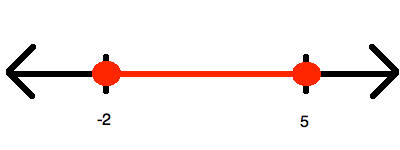All PSAT Math Resources
Example Questions
Example Question #1773 : Psat Mathematics

Which of the following inequalities is represented by the number line shown above?
Since the inequality represents one range of values between two end points (both of which are included, given the sign being "less than or equal"), you know that whatever you answer, it must be convertible to the form:
Now, you know that it is impossible to get this out of the choices that have no absolute values involved in them. Therefore, the only options that make sense are the two having absolute values; however, here you should choose only the ones that have a 
The wrong answer is simplified in this manner:
And you can stop right here, for you know you will never have 
The other option is simplified in this manner:
This is just what you need!
Example Question #52 : Integers
Which of the following is a graph for the values of 






Begin by solving for 
Now, this is represented by drawing an open circle at 6 and graphing upward to infinity:

Example Question #1 : How To Find Value With A Number Line
If the tick marks are equally spaced on the number line above, what is the average (arithmetic mean) of x, y, and z?
6
5
7
4
8
6
First, we must find out by how much they are spaced by. It cannot be 1, since 4(4) = 16, which is too great of a step in the positive direction and exceeds the equal-spacing limit. 2 works perfectly, however, as 4(2) equals 8 and fits in line with the equal spacing.
Next, we can find the values of x and y since we are given a value of 6 for the third tick mark. As such, x (6 – 4) and y (6 – 2) are 2 and 4, respectively.
Finally, z is 4 steps away from y, and since each step has a value of 2, 2(4) = 8, plus the value that y is already at, 8 + 4 = 12 (or can simply count).
Finding the average of all 3 values, we get (2 + 4 + 12)/3 = 18/3 = 6.
Example Question #2 : How To Find Value With A Number Line
How many numbers 1 to 250 inclusive are cubes of integers?
The cubes of integers from 1 to 250 are 1, 8, 27,64,125,216.
Example Question #1 : How To Find Value With A Number Line

Refer to the above number line. Which of the points is most likely the location of the number 

Therefore,
On the number line, 
Example Question #1 : How To Add Negative Numbers
How many elements of the set 

One
Four
None
Two
Three
Four
The absolute value of a negative number can be calculated by simply removing the negative symbol. Therefore,
All four (negative) numbers in the set 
Example Question #2 : How To Add Negative Numbers
a, b, c are integers.
abc < 0
ab > 0
bc > 0
Which of the following must be true?
a > 0
a + b < 0
a – b > 0
b > 0
ac < 0
a + b < 0
Let's reductively consider what this data tells us.
Consider each group (a,b,c) as a group of signs.
From abc < 0, we know that the following are possible:
(–, +, +), (+, –, +), (+, +, –), (–, –, –)
From ab > 0, we know that we must eliminate (–, +, +) and (+, –, +)
From bc > 0, we know that we must eliminate (+, +, –)
Therefore, any of our answers must hold for (–, –, –)
This eliminates immediately a > 0, b > 0
Likewise, it eliminates a – b > 0 because we do not know the relative sizes of a and b. This could therefore be positive or negative.
Finally, ac is a product of negatives and is therefore positive. Hence ac < 0 does not hold.
We are left with a + b < 0, which is true, for two negatives added must be negative.
Example Question #1 : How To Divide Negative Numbers
What is 
45
A negative number divided by a negative number always results in a positive number. 



Example Question #2 : How To Divide Negative Numbers
Solve for 
Begin by isolating your variable.
Subtract 

Next, subtract 

Then, divide both sides by 
Recall that division of a negative by a negative gives you a positive, therefore:

Example Question #1 : How To Multiply Negative Numbers
If 


Because 

Because 

To check you answer, you can try plugging in any negative number for 
All PSAT Math Resources






















































